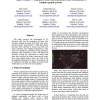Free Online Productivity Tools
i2Speak
i2Symbol
i2OCR
iTex2Img
iWeb2Print
iWeb2Shot
i2Type
iPdf2Split
iPdf2Merge
i2Bopomofo
i2Arabic
i2Style
i2Image
i2PDF
iLatex2Rtf
Sci2ools
ICAT
2007
IEEE
2007
IEEE
"Space Frames": Using space, color and animation in the visualization of complex graph systems
This study concerns the development of 3D interfaces that aid the navigation of large data structures through the usage of the HSV color space, and the ensuing “spatial frames”. While data objects that have been colorized in various hues that carry equal saturation and brightness/transparency value seem to be equally fore grounded; varying saturation, brightness and transparency values add depth and hierarchy. During our experiments we noticed that, when thus colorized, the edges connecting the nodes form visual spatial frames, which can result in the meaningful partitioning of 3D space. This property can be exploited to facilitate the display of overall trends within data sets, as well as to ease navigation.
| Added | 02 Jun 2010 |
| Updated | 02 Jun 2010 |
| Type | Conference |
| Year | 2007 |
| Where | ICAT |
| Authors | Elif E. Ayiter, Selim Balcisoy, Murat Germen, Ismail Kasarci, Uraz C. Turker, Merve Cayli |
Comments (0)

